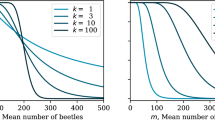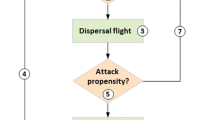Abstract
Pattern formation occurs in a wide range of biological systems. This pattern formation can occur in mathematical models because of diffusion-driven instability or due to the interaction between reaction, diffusion, and chemotaxis. In this paper, we investigate the spatial pattern formation of attack clusters in a system for Mountain Pine Beetle. The pattern formation (aggregation) of the Mountain Pine Beetle in order to attack susceptible trees is crucial for their survival and reproduction. We use a reaction-diffusion equation with chemotaxis to model the interaction between Mountain Pine Beetle, Mountain Pine Beetle pheromones, and susceptible trees. Mathematical analysis is utilized to discover the spacing in-between beetle attacks on the susceptible landscape. The model predictions are verified by analysing aerial detection survey data of Mountain Pine Beetle Attack from the Sawtooth National Recreation Area. We find that the distance between Mountain Pine Beetle attack clusters predicted by our model closely corresponds to the observed attack data in the Sawtooth National Recreation Area. These results clarify the spatial mechanisms controlling the transition from incipient to epidemic populations and may lead to control measures which protect forests from Mountain Pine Beetle outbreak.



Similar content being viewed by others
References
Aukema, B. H., Carroll, A. L., Zheng, Y., Zhu, J., Raffa, K. F., Moore, R. D., Stahl, K., & Taylor, S. W. (2008). Movement of outbreak populations of mountain pine beetle: influences of spatiotemporal patterns and climate. Ecography, 31, 348–358.
Bentz, B. J., Powell, J. A., & Logan, J. A. (1996). Localized spatial and temporal attack dynamics of the mountain pine beetle in lodgepole pine. Intermountain Research Paper, 494.
Biesinger, Z., Powell, J., Bentz, B., & Logan, J. (2000). Direct and indirect parameterization of a localized model for the mountain pine beetle-lodgepole pine system. Ecol. Model., 129, 273–296.
Brooks, J. E., & Stone, J. E. (2003). Mountain pine beetle symposium: challenges and solutions. Natural Resources Canada, Canadian Forest Service, Pacific Forestry Centre, Victoria, BC.
Budrene, E. O., & Berg, H. C. (1991). Complex patterns formed by motile cells of Escherichia coli. Nature, 349(6310), 630–633.
Budrene, E. O., & Berg, H. C. (1995). Dynamics of formation of symmetrical patterns by chemotactic bacteria. Nature, 376(6535), 49–53.
Burnell, D. G. (1977). A dispersal-aggregation model for mountain pine beetle in lodgepole pine stands. Res. Popul. Ecol., 19, 99–106.
Carrasco, L. R., Mumford, J. D., MacLeod, A., Harwood, T., Grabenweger, G., Leach, A. W., Knight, J. D., & Baker, R. H. A. (2010). Unveiling human-assisted dispersal mechanisms in invasive alien insects: integration of spatial stochastic simulation and phenology models. Ecol. Model., 221, 2068–2075.
Crabb, B. A., Powell, J. A., & Bentz, B. J. (2012). Development and assessment of 30-m pine density maps for landscape-level modeling of mountain pine beetle dynamics. USDA FS Rocky Mountain Research Station Research Note.
Gamarra, J. G. P., & He, F. (2008). Spatial scaling of mountain pine beetle infestations. J. Anim. Ecol., 77, 796–801.
Geiszler, D. R., Gallucci, V. F., & Gara, R. I. (1980). Modeling the dynamics of mountain pine beetle aggregation in a lodgepole pine stand. Oecologia (Berl.), 46, 244–253.
Gilbert, E., Powell, J. A., Logan, J. A., & Bentz, B. J. (2004). Comparison of three models predicting developmental milestones given environmental and individual variation. Bull. Math. Biol., 66, 1821–1850.
Haefner, J. W. (Ed.) (2005). Modeling biological systems. New York: Springer.
Heavilin, J., & Powell, J. (2008). A novel method of fitting spatio-temporal models to data, with applications to the dynamics of mountain pine beetles. Nat. Resour. Model., 21(4), 489–524.
Hughes, J., Fall, A., Safranyik, L., & Lertzman, K. (2006). Modeling the effect of landscape pattern on mountain pine beetles. Technical report BC-X-407, Natural Resources Canada, Canadian Forest Service, Pacific Forestry Centre, Victoria, British Columbia.
Lewis, M. A., & Pacala, S. (2000). Modeling and analysis of stochastic invasion processes. J. Math. Biol., 41, 387–429.
Logan, J. A., & Powell, J. A. (2001). Ghost forests, global warming and the mountain pine beetle (coleoptera) Scolytidae. Am. Entomol., 47, 160–173.
Logan, J. A., White, P., Bentz, B. J., & Powell, J. A. (1998). Model analysis of spatial patterns in mountain pine beetle outbreaks. Theor. Popul. Biol., 53, 236–255.
Mack, R. N., Simberloff, D., Lonsdale, W. M., Evans, H., Clout, M., & Bazzaz, F. (2000). Biotic invasions: causes, epidemiology, consequences, and global control. Issues Ecol., 5, 1–20.
Mitchell, R. G., & Preisler, H. K. (1991). Analysis of spatial patterns of lodgepole pine attacked by outbreak populations of the mountain pine beetle. For. Sci., 37(5), 1390–1408.
Murray, J. D. (2003). Mathematical biology. Berlin: Springer.
Nagle, R. K., Saff, E. B., & Snider, A. D. (Eds.) (2005). Fundamentals of differential equations and boundary value problems. Boston: Pearson.
Peltonen, M., Liebhold, A. M., Bjornstad, O. N., & Williams, D. W. (2002). Spatial synchrony in forest insect outbreaks: roles of regional stochasticity and dispersal. Ecology, 83(11), 3120–3129.
Pérez, L., & Dragićević, S. (2011). ForestSimMPB: a swarming intelligence and agent-based modeling approach for mountain pine beetle outbreaks. Ecol. Inform., 6, 62–72.
Petrovskii, S., & McKay, K. (2010). Biological invasion and biological control: a case study of the gypsy moth spread. Asp. Appl. Biol., 104, 37–48.
Polymenopoulos, A. D., & Long, G. (1990). Estimation and evaluation methods for population growth models with spatial diffusion: dynamics of mountain pine beetle. Ecol. Model., 51, 97–121.
Powell, J., & Bentz, B. (2009). Connecting phenological predictions with population growth rates for mountain pine beetle, an outbreak insect. Landsc. Ecol., 24, 657–672.
Powell, J. A., & Logan, J. A. (2005). Insect seasonality – circle map analysis of temperature-driven life cycles. Theor. Popul. Biol., 67, 161–179.
Powell, J. A., Mcmillen, T., & White, P. (1998). Connecting a chemotactic model for mass attack to a rapid integro-difference emulation strategy. SIAM J. Appl. Math., 59(2), 547–552.
Raffa, K. F., & Berryman, A. A. (1983). The role of host plant resistance in the colonization behaviour and ecology of bark beetles (coleoptera) scolytidae. Ecol. Monogr., 53(1), 27–49.
Riel, W. G., Fall, A., Shore, T. L., & Safranyik, L. (2004). A spatiotemporal simulation of mountain pine beetle impacts on the landscape. Technical report BC-X-399, Natural Resources Canada, Canadian Forest Service, Pacific Forestry Centre, Victoria, British Columbia.
Robertson, C., Nelson, T. A., Jelinski, D. E., Wulder, M. A., & Boots, B. (2009). Spatial-temporal analysis of species range expansion: the case of the mountain pine beetle, Dendroctonus ponderosae. J. Biogeogr., 36(8), 1446–1458.
Safranyik, L. & Wilson, B. (Eds.) (2006). The mountain pine beetle. Natural Resources Canada, Canadian Forest Service, Pacific Forestry Center, Victoria, BC, Canada.
Safranyik, L., Barclay, H., Thomson, A., & Riel, W. G. (1999). A population dynamics model for the mountain pine beetle, Dendroctonus ponderosae Hopk. (coleoptera: Scolytidae). Technical report BC-X-386, Natural Resources Canada, Canadian Forest Service, Pacific Forestry Centre, Victoria, British Columbia.
Samman, S., & Logan, J. (2000). Assessment and response to bark beetle outbreaks in the rock mountain area. Technical report RMRS-GTR-62, U.S. Department of Agriculture, Forest Service, Rocky Mountain Research Station, Ogden, UT, U.S.
Shigesada, N., Kawasaki, K., & Takeda, Y. (1995). Modeling stratified diffusion in biological invasions. Am. Nat., 146(2), 229–251.
Smith, D. E., & Latham, M. L. (1954). The geometry of Rene Descartes with a facsimile of the first edition. New York: Dover.
Turing, A. M. (1952). The chemical basis of morphogenesis. Philos. Trans. R. Soc. Lond. B, 237, 37–72.
Tyson, R. C. (1996). Pattern formation by E. coli - mathematical and numerical investigation of a biological phenomenon. PhD thesis, University of Washington.
Tyson, R., Lubkin, S. R., & Murray, J. D. (1999). Model and analysis of chemotactic bacterial patterns in a liquid medium. J. Math. Biol., 38(4), 359–375.
White, P., & Powell, J. (1997). Phase transition from environmental to dynamic determinism in mountain pine beetle attack. Bull. Math. Biol., 59, 609–643.
Acknowledgements
Funding for this project was provided by NSERC (SS,RT), PIMS IGTC (SS), MITACS (SS,RT), UBC Okanagan (SS,RT), NSF DEB 0918756 (JP), and WWETAC (JP). We would like to acknowledge the assistance of Mary Reid and Kurt Trzcinski in developing the mathematical model and Daniel Coombs, Sylvie Desjardins, and the Tyson lab group for insightful comments. Further, we would like to thank the reviewers for their valuable suggestions.
Author information
Authors and Affiliations
Corresponding author
Appendix
Appendix
1.1 A.1 Estimating Allee Attack Threshold, k p
The parameter k p is the density of flying MPB required for 50 % nesting beetle success. Assuming each female beetle makes a single gallery, we estimate the density of flying MPB required for a 50 per cent success of mass attack to be 40 beetles/m2 (Raffa and Berryman 1983). Since our model uses area in ha instead of m2, we must multiply this quantity by a conversion factor
where B h is the number of beetles per hectare, B m is the number of beetles per m2, SA is the surface area of the tree attacked, and TA is the area within which a beetle is considered to be “attacking” a tree.
Assuming that the basal 7.5 m of a tree can be attacked (Raffa and Berryman 1983), we find the surface area as SA=πdh, where the tree diameter, d, can range from 0.1874 to 0.3456 m and the height h is taken to be 7.5 m. Therefore, SA can range from 4.42 to 8.14 m2. We assume that beetles will attack within a 10 m2 area of the tree, TA=10 m2=10−3 ha, which makes k p =176800–325600 beetles/ha. We initially assume the value of k p =250000 MPB/ha.
1.2 A.2 FFT Analysis of MPB Data
An example of the FFT analysis of the data (in 2007) is shown in Fig. 4. Each year the landscape was analysed for regions of incipient epidemic densities of MPB. The size and number of regions chosen in each year is displayed in Fig. 5.
The SNRA (top left) is plotted for 2007, where white areas denote regions of MPB attack. The red highlighted region (left bottom) is analysed using Discrete fast Fourier transforms to determine the power spectral density (right). In this graph, the dominant wavenumber (ν d ) is represented by a solid red dot, and the upper (ν u ) and lower (ν l ) bounds on the dominant wavenumber are displayed with vertical green and black lines, respectively (Color figure online)
Rights and permissions
About this article
Cite this article
Strohm, S., Tyson, R.C. & Powell, J.A. Pattern Formation in a Model for Mountain Pine Beetle Dispersal: Linking Model Predictions to Data. Bull Math Biol 75, 1778–1797 (2013). https://doi.org/10.1007/s11538-013-9868-8
Received:
Accepted:
Published:
Issue Date:
DOI: https://doi.org/10.1007/s11538-013-9868-8






